Rust diseases in ornamentals
Rust diseases are common fungal infections that affect a wide range of floricultural crops, including Carnation, Roses, Chrysanthemums, Hypericums, Fuchsia, Geraniums, Gladiolus, Lilium, Marigold, Poinsettia, Snapdragons, Statice and Viola (including pansy). Rusts have the potential to negatively impact floriculture production. Rust fungi are obligate parasites, dependent upon a live host for growth and development, and seldom kill plants. However, rust infection reduces plant health and vigor, flower production, and aesthetic value.
Symptoms
Each type of Rust has its own distinctive symptoms and its own specific plant hosts. The disease often first appears as chlorosis on the upper surfaces of leaves. All rust fungi produce powdery masses of spores in pustules, typically on leaf undersides that are yellow, orange, purple, black or brown. Some Rust fungi produce pustules on upper leaf surfaces as well. Spores are easily spread on air or with splashing water. Lesions may coalesce resulting in large areas of necrosis; leaf distortion and defoliation often follow.
Life cycle
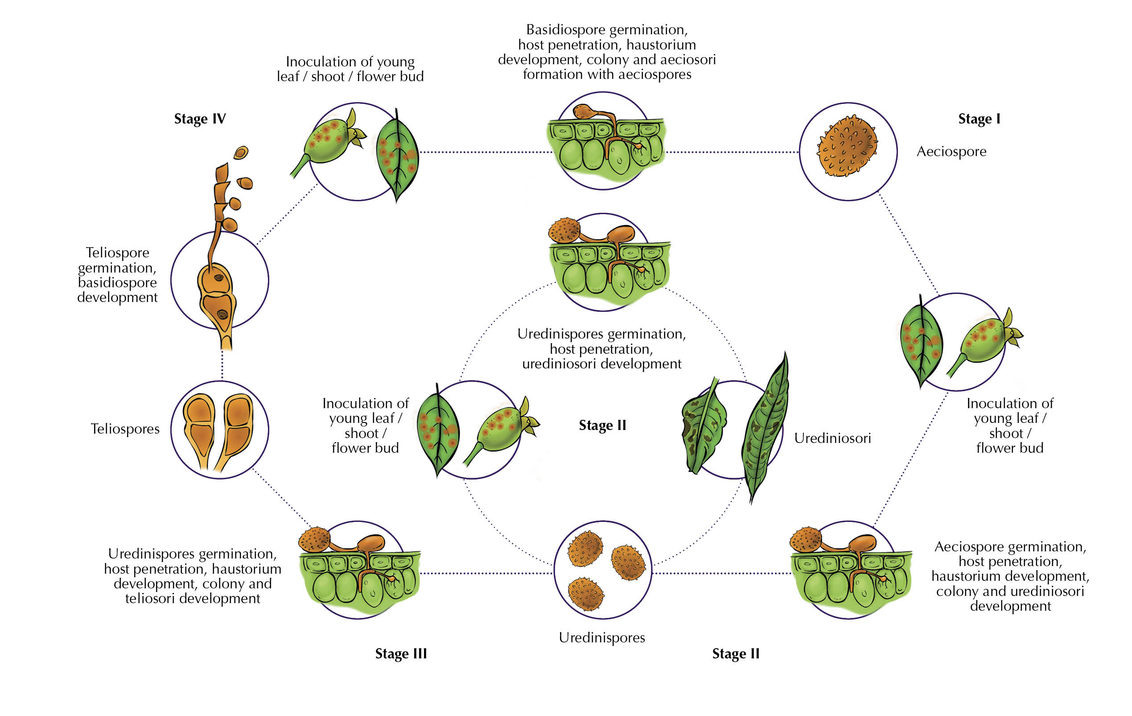
Rust produces four spore stages, but only roses are affected. Urediospores ("repeating spores") are produced in yellow, orange, or brown pustules and spread the disease rapidly. Rusts usually spend the winter as teliospores, which require a dormant period before germination. Basidiospores are produced from germinating teliospores and start the initial infection. One infection is established, aeciospores are produced, often upon alternate hosts, in cup-shaped bodies that are easily seen. The aeciospores cannot reinfect the host upon which they are produced, only the alternate host, which produces the repeating spores (urediospores).
Rose rust

Caused by Phragimidium mucronatum first appears in the spring as bright orange pustules on leaf undersides, leaf stalks and branches. In the summer, small raised orange spots appear on the undersides of leaves with small yellow specks on the upper surface beginning on the lower leaves and moving upward. The spots may go unnoticed until the plant begins to exhibit a generally unhealthy appearance and a loss of the lower leaves. Leaves may become dry and twisted before falling off.
Carnation rust
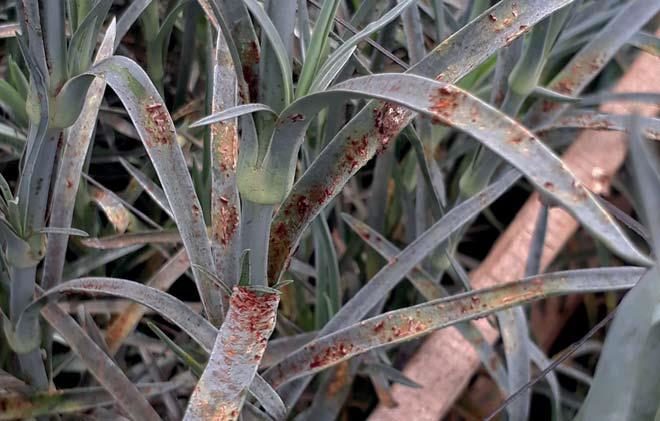
Caused by Uromyces diantha, this rust disease is characterized by small pustules of powdery, brown urediospores. These spores are carried over only on live plants. Resistant cultivars are available.
Chrysanthemum rust
Two species of Puccinia causes rust on chrysanthemums P. chrysanthemi and P. horiana. P. chrysanthemi is characterized by dirty-brown pustules and yellowish-green spots on upper surfaces of leaves. It causes minor damage in the field and is uncommon on greenhouse plants. Severe infestation may damage large areas of leaves and lead to defoliation and reduced flower production.
P. horiana causes Chrysanthemum white rust and the symptoms are white, pinkish or brownish pustules produced on leaf undersides with white, yellow, to pale-green lesions on upper leaf surfaces. Chrysanthemum white rust results in leaf distortion, discoloration, defoliation, and plant death.
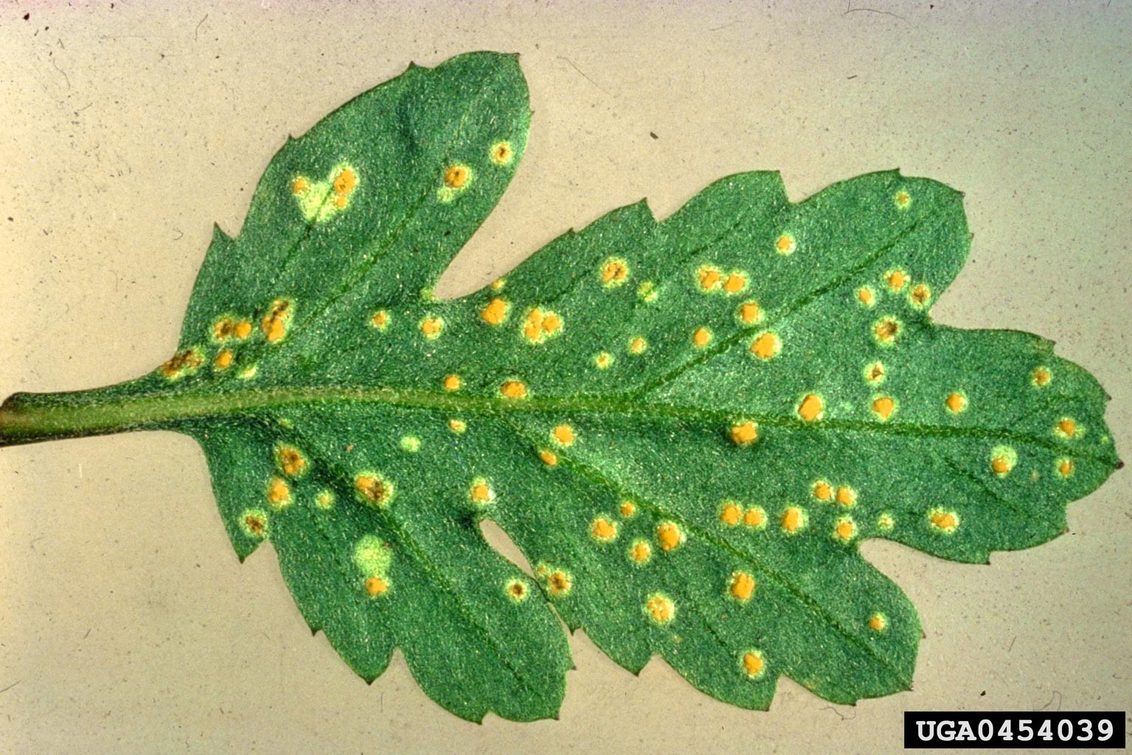
Viola species rust
Caused by Puccinia viola and symptoms first appear as small, pale green spots on the upper leaf surface. As the fungus develops within the leaf, corky spots, blisters, or pustules containing rusty brown spores develop on leaf undersides.
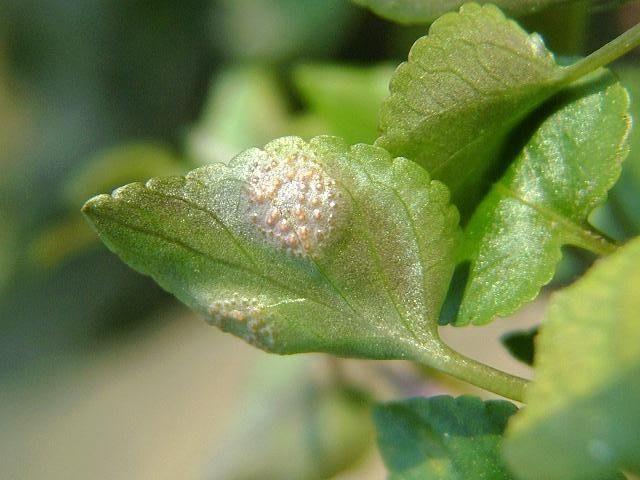
Geranium rust
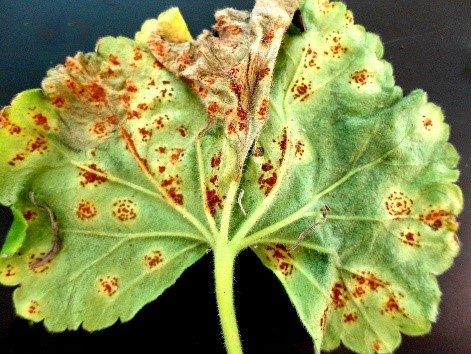
Caused by Puccinia pelargoni-zonalis is most serious on Florist's geraniums, but has also been reported on zonal geraniums and seedling geraniums. Geranium rust occurs throughout due to the ease with which it is spread on infected cuttings. This rust spends its entire life cycle on geranium (autoecious). Symptoms first appear as small, circular, yellow spots on the top of leaves opposite the pustules on the lower leaf surface. The spots on the lower leaves enlarge to blister-like pustules of rust to cinnamon brown spores which often develop in concentric rings.
Management of rust diseases
Purchase only disease-free plants or cuttings. Frequently remove all rust-infected leaves and badly infected plants and destroy by burning, rapid composting, or burying At the end of the growing season, carefully clean up and destroy all crop debris. Sterilize benches and propagation rooms with an appropriate greenhouse disinfectant. Keep the humidity within the greenhouse at less than 80%. Practice only surface watering and avoid splashing water onto foliage. Space plants to allow for good air circulation. A combination of cultural and chemical control is often required to control rust diseases.
Chemical control recommendations
Daconil, Ortiva, Ortiva Top, Score, Solvit and Thiovit
To find out more about rust disease in your horticulture crops here.
